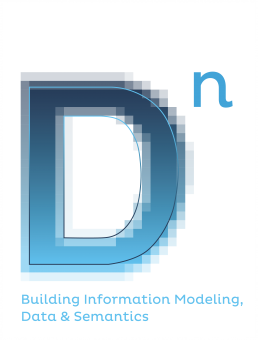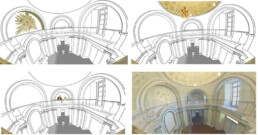Possible solutions for metamodelling: the BIM grey box
ABSTRACT
The paper aims at investigating the HBIM metamodelling characteristics focusing on the different strategies for model’s construction. This topic is developed proposing a parallelism with testing typologies used in the field of computer science. This parallelism wants to introduce a new way to approach the model, the grey box, to combine ideality and physicality of the building.
Carlo Bianchini , Marika Griffo, Luca James Senatore
Sapienza, Università di Roma, Dipartimento di Storia, Disegno e Restauro dell’Architettura
Virtual Narrative Environments for Cultural Heritage: the case study of the Marini Museum in Florence
ABSTRACT
A virtual environment, if well designed, can improve the understanding of architectural space, in particular, when the perceptual system is impaired such as in autism. The present paper reports a case study for the design of a guidelines tool aimed at the best representation in VR for an ASD audience and for acrophobia.
Greta Attademo
Università degli studi di Napoli, Dipartimento di Architettura
An inclusive design of virtual environments to improve the relationship with architectural space and problems of acrophobia
ABSTRACT
A virtual environment, if well designed, can improve the understanding of architectural space, in particular, when the perceptual system is impaired such as in autism. The present paper reports a case study for the design of a guidelines tool aimed at the best representation in VR for an ASD audience and for acrophobia.
Anna Lisa Pecora
Università Federico II di Napoli
Game Engine Applications Overview And Comparative Analysis For The Enhancement Of Cultural Heritage
ABSTRACT
Digital reconstructions of artefacts and architectures increasingly mediate the use of cultural heritage, virtual tours of museums, shared social spaces, and augmented or mixed reality applications that support direct or simulated experience, opening to a new interdisciplinary sector known as Digital Heritage. In the sector of drawing and representation, the potential of digital surveying and advanced 3D data models have been studied accurately. However, enhancing any cultural asset requires additional interpretation levels of documentation and narrative structures necessary to implement engaging, interactive experiences suitable for effective cultural dissemination. Therefore, specific software tools, known as game engines, are required to synthesize heterogeneous expressive languages in a single interactive structure. This paper analyzes and frames the game engines available today while developing a categorization method that outlines a theory of use in the field of Digital Heritage.
Giuseppe Amoruso, Giorgio Buratti
Politecnico di Milano
Index Volume 9
INDEX
Editorial
T. Empler, G. M. Valenti
Scan-to-HBIM: integrated survey and information modelling for the documentation of structural damage
S. Balin, G. Cardani, F. Fiorillo
HBIM for public administration management. The case study of Palazzo Vitelli alla Cannoniera.
F. Bianconi, M. Filippucci, A. Parisi, S. Battaglini
Documentation of the waterways in the pavia flat land. Experience in detection with SLAM technology for the development of information models
S. Parrinello, S. La Placa
Machine Learning Experiences for Information Enrichment of HBIM Models: the DECAI Project
M. Lo Turco, A. Tomalini
Knowledge of historical heritage: between semantics and ontology
S. Mollica
Energy Digital Twin: an HBIM procedure for energy redevelopment in historic buildings
A. Caldarone
Editorial Vol. 09
Application areas of BIM in the last 6 months have significantly increased for various reasons. There have been changes from a regulatory point of view (Ministerial Decree August 2, 2021, n. 312, entitled “Amendments to the decree of the Ministry of Infrastructure and Transport December 1, 2017, n. 560”), awards are recognized for application of BIM procedures in planning and execution of public tenders, specific requests are formulated in PNRR calls, and finally, application procedures to Cultural Heritage are are significantly improved, where there are elements of digital and industrial innovation, which produce actions compatible with protection and environmental sustainability.
From a regulatory point of view, most relevant introductions refer to the search for methodological solutions related to some key concepts, referred to art. 7 bis of the Ministerial Decree 2 August 2021, n. 312, as: “information models”; “Reward scores for the use of specific electronic methods and tools”; “Maintenance of interoperability characteristics of information models”; “Innovative tools of augmented reality”.
Awards refer to the proposal to use BIM methodology in improvement offers related to presentation of projects subject to public funding and in tenders. Procedures applied to Cultural Heritage (HBIM) present the most innovative aspects, because interoperability becomes a fundamental way to make the models, generated for specific application areas, communicate with each other with models referring to other disciplines or applications. Among these, notable progress of the state of the art are connected to the use of the VPL (Visual Programming Language), which allows to maintain the syntactic and morphological characteristics of a historical architectural organism even when its parts or components must be “informed” and “parameterized”.
Precisely in this scenario, of transformation and development of methodologies, tools and operational best practices in BIM and HBIM fields, we wanted to photograph the moment and ask the scientific community for a moment of reflection, to share, to fully understand where we are, in which direction we are going and where we could go further. Thus was born the call of Dn number 9, which invited to focus attention on relationship between original thought and artificial thought, between direct “manual” work and indirect one of digital automatisms. A substantial and necessary reflection to address challenges and objectives that today’s Europe offers us, so as to proceed towards continuous digital and industrial innovation, in compliance with full compatibility and environmental protection.
Area of Information Modeling dedicated to Cultural Heritage appears to be a suitable field to investigate and dissect these issues, as shown by the papers present in this issue of the magazine, which propose innovative solutions for HBIM area and suggest reference objectives towards which future experimental and operational resources should be directed. There is a growing awareness of importance of information integration and how its complexity and articulation, on an ontological and semantic level, is proportionately problematic and critical with the increasing historical stratification that affects the building described (Sonia Mollica).
Integration of building’s information qualities also has a multidimensional and at the same time complementary character. For example, experimental activities are of fundamental importance for the definition of new “information enrichment” methodologies, useful for documenting structural problems, such as cracks and disruptions, and providing a synchronic and diachronic reading with respect to historical progression of phenomena – exogenous and endogenous – intervened on the building (Simone Balin, Giuliana Cardani, Fausta Fiorillo).
However, perfecting information has the onerous commitment of managing and organizing huge amounts of data, the management of which requires both in survey step, in normalization, and in representation, a rigorous procedural and methodological organization, which makes use of aids semi-automatic and automatic digital. In this area of investigation researches that exploit the most recent and “lean” acquisition and preprocessing technologies that operate directly in the field (Sandro Parrinello, Silvia La Placa) are proceeding successfully; as well as experiences that structure methodologically and test machine learning procedures for classification of detected surfaces and their annotation in HBIM environment (Massimiliano Lo Turco, Andrea Tomalini).
Amount of survey data, which can now be quickly acquired on a building, must always be integrated – where present – with previous analogue and digital documentation. Therefore, those research activities that normalize and make organically usable, to those who work in management of building, heterogeneous information and their related integrated representations deserve particular attention. (F. Bianconi, M. Filippucci, A. Parisi, S. Battaglini).
Finally, of particular strategic relevance, are researches that propose levels of classification of quality of building surveyed, such as those aimed at defining a Level of Sustainability: an index aimed at describing a level of environmental sustainability and guiding the restoration and redevelopment project energy. A panorama of case studies, therefore, particularly varied, rich and mature, on which to certainly base next innovation.
Tommaso Empler, Graziano Mario Valenti
Energy Digital Twin: an HBIM procedure for energy redevelopment in historic buildings
ABSTRACT
A recent ministerial decree n. 77/2020 provides tax deductions and incentives in order to make the building heritage more efficient. This highlighted the issue of energy efficiency in historic buildings, which are arduos, as compliance with the requirements could cause an unacceptable alteration of building’s historic – artistic values. Following workflow defines an assessment system based on Level of Sustainability which is a digital that allows Code Checking and that evaluates (without giving value judgments) environmental, cultural and economic level of sustainability of a restoration, in order to obtain an environmentally-historic-aware energy upgrading.
Adriana Caldarone
Sapienza Università di Roma
Knowledge of historical heritage: between semantics and ontology
ABSTRACT
Modeling in the BIM environment is today increasingly aimed at maximizing and integrating historical, semantic and ontological information, or rather a challenge to which this contribution investigates through the case study of Italian lighthouses.
Sonia Mollica
Università Mediterranea di Reggio Calabria
Machine Learning Experiences for Information Enrichment of HBIM Models: the DECAI Project
ABSTRACT
In the management process of the architectural restoration site, we are witnessing the adoption of processes conducted largely in the traditional way increasingly alongside activities strongly influenced by new technologies. In particular, the new instruments for the metric survey return more and more information at very high resolution, progressively reducing the acquisition time. In recent years, In order to manage and structure these data, the disciplines of Representation and Geomatics have developed increasingly efficient restitution workflows by applying Building Information Modeling (BIM) processes to the built heritage (HBIM). While the acquisition tools have evolved rapidly, the same cannot be said for the methodologies for managing the collected data and the tools for informed models. At the regard, there is a growing need to apply Machine Learning processes to improve data management and modelling in heritage restitution processes.
The paper briefly presents the semi-automatic DECAI workflow for mapping architectural surfaces and their annotation in the HBIM environment. The case study is the elevation on Via Porta Praetoria, the facades of the hallway and the facades of the internal cavity of Palazzo Ansermin, in Aosta. The paper does not presume to replace the traditional survey procedures but rather to propose an integration and optimization, following a workflow that starts with a photogrammetric survey and ends with the informative enrichment of an HBIM model of the building.
Massimiliano Lo Turco, Andrea Tomalini
Department of Architecture and Design - DAD, Politecnico di Torino
Documentation of the waterways in the pavia flat land. Experience in detection with SLAM technology for the development of information models
ABSTRACT
The research, promoted by the DAda-LAB Laboratory of the University of Pavia, aims to structure a methodology and an operational protocol for the documentation of water canals in the Pavia territory. This protocol appears necessary to optimize the various phases that characterize both the documentation activities and the three-dimensional graphic representation of the agricultural territories of the flat land and their canalization networks through information systems.
The study evaluates the most functional procedures to respect a infographics conformity in the building of reliable 3D models.
The investigation activities see the construction of digital atlases on the elements that constitute the landscape.
The result aims to product an informatic system to promote territory knowledge. This product qualifies as a documentary corpus made up of models, census data, and more generally of information systems connected to point clouds and 3D surveys. The result allows obtaining technical information, functional to administrations and consortia to simplify and improve the management of the territory, with economic and productive advantages.
Sandro Parrinello, Silvia La Placa
Università degli Studi di Pavia, DICAr – Dipartimento di Ingeneria Civile e Architettura








